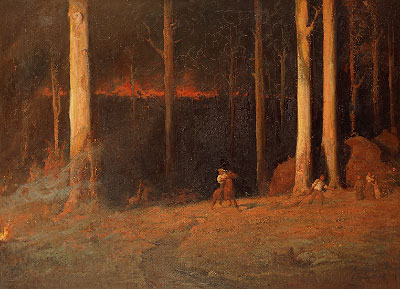 Rather it's a painting I saw it today in the National Gallery of Victoria. It's by John Longstaff and called "Gippsland, Sunday night, February 20th, 1898." The 1898 conflagration, known as the Red Tuesday bushfire, burned 260,000 hectares. 2000 houses destroyed, and a dozen people killed.
Rather it's a painting I saw it today in the National Gallery of Victoria. It's by John Longstaff and called "Gippsland, Sunday night, February 20th, 1898." The 1898 conflagration, known as the Red Tuesday bushfire, burned 260,000 hectares. 2000 houses destroyed, and a dozen people killed.The painting itself is very powerful, nearly 1.5 meters high and 2 across, with bolting horses, terrified people, and that frightening line of fire on a horizon which might be distant but is probably close. Especially interesting are disturbances of the paint surface in the tops of the trees and, especially, in the black area at the painting's center. (You can even see them as fine white lines in this photo.) The canvas looks charred! Whether Longstaff managed to create this effect deliberately or whether it's just what happens to deep black paint after a century I do not know, but it adds to the visceral power of the painting, and the danger it communicates. It's almost as if the fire has burnt the canvas from behind.
On a day when you can taste in the Melbourne air the ash from this season's first Gippsland fires (today saw the merging of bush fires which between them have already incinerated 680,000 hectares), you can really understand that Australians live with a sense of natural danger. (Now I see why you might read your children the Possum Creek Disaster stories I described bemusedly two months ago.) The fatalism I sense around me is greater than what we feel about brushfires back in California, regular and destructive though they are, and closer to what Japanese feel about earthquakes.